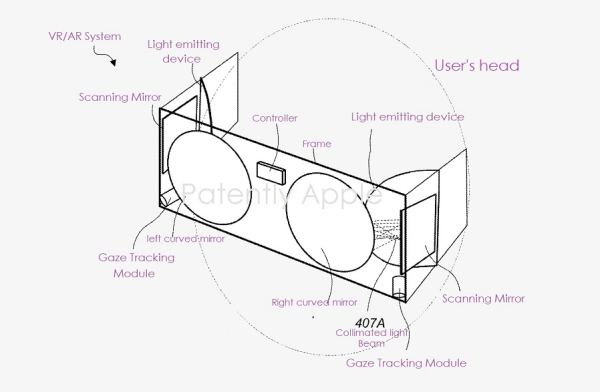
Source: www.patentlyapple.com
Today, the US Patent and Trademark Office officially granted Apple a patent related to a mixed reality headset with a Dynamic Focus 3D display. While conventional VR systems project left and right images onto screens viewed by a subject, Apple’s new way uses a direct retinal projector system that scans images, pixel by pixel, directly onto the subject’s retinas.
In general, Apple claims that its invention covers a direct retina projector system that provides dynamic focus for virtual reality (VR) and/or augmented reality (AR). A direct retinal projector system scans images, pixel by pixel, directly onto the subject’s retinas. This allows individual pixels to be dynamically affected optically as images are scanned onto the subject’s retinas. Dynamic focusing components and techniques are described that can be used in a direct retinal projector system to dynamically and correctly focus each pixel in virtual reality images as the images are scanned into the eyes of a subject. This allows objects, surfaces, etc. that need to appear at different distances in a scene are projected into the subject’s eyes at the correct depth.
Also, in a stereoscopic system, images displayed to the user can trick the eyes into focusing at a far distance while an image is physically displayed at a closer distance. In other words, the eyes may be trying to focus on a different image plane or focal depth compared to the focal depth of the projected image, causing eyestrain and/or increased mental stress.
Accommodation convergence mismatch issues are undesirable and can distract users or detract from their levels of enjoyment and endurance (ie, tolerance) of virtual reality or augmented reality environments. Apple’s invention is to overcome this problem.
Dynamic focus component embodiments and techniques are described for direct retinal projector systems that can, for example, resolve the convergence-accommodation conflict in AR and VR systems.
Embodiments of the dynamic focusing components and techniques can be used in a direct retinal projector system to correctly focus each pixel in virtual reality images as the images are scanned into the eyes of a subject.
A VR or AR headset system is described that may include or implement the dynamic focus components and techniques in a direct retinal projector system.
The human brain typically uses two signals to measure distance: accommodation (ie, the focus of the eye) and convergence of the eye (ie, the difference in stereoscopic perspective between the two eyes). Conventional near-eye virtual reality systems, such as DLP (digital light processing), LCD (liquid crystal display), and LCoS (liquid crystal on silicon) VR systems, typically use separate screens for each respective eye to project images intended for the left eye. eye and right eye, as well as optics for allowing a user to focus the eyes at a far distance while viewing left and right eye images.
To create a three-dimensional (3D) effect, objects at different depths or distances in the two images are shifted left or right based on the distance triangulation, with closer objects shifted more than more distant objects .
While conventional VR systems project left and right images onto screens viewed by a subject, Apple’s new way uses a direct retinal projector system that scans images, pixel by pixel, directly onto the subject’s retinas.
This aspect of direct retinal projector systems allows individual pixels to be optically affected dynamically as images are scanned onto the subject’s retinas. Dynamic focusing components and techniques used in the patent granted by Apple can be used in a direct retinal projector system to dynamically and correctly focus each pixel in virtual reality images as the images are scanned into a subject’s eyes .
This allows content (objects, surfaces, etc.) that should appear at different depths in a scene to be projected to the subject’s eyes at the correct depths.
Apple Patent FIG. 14 is a logic block diagram of a framework for a VR/AR device; FIG. 15 is a logic block diagram of a device that provides augmented reality (AR) to a subject.
Apple has added 20 new patent claims to its original invention covering “An Apparatus” and “A System”. For more details, review Apple’s issued patent 11,070,785.
The inventor of Apple is Alexander Shpunt, an architect, he came to Apple after the acquisition of Israel’s PrimeSense which was behind Apple’s TrueDepth camera. Being the inventor of this invention gives you more credibility and a chance of making it to market.
Read More at www.patentlyapple.com